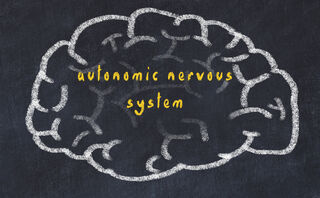Neuroscience
Your Body's Motto: Danger Until Proven Otherwise
Restoring a sense of safety is the only way out from the threat of chronic pain.
Posted March 4, 2022 Reviewed by Hara Estroff Marano
Key points
- When sensing danger (threat), your body receives signals to mobilize, consume more fuel, become inflamed—which causes disease if sustained.
- In order to heal and regenerate, your body must receive cues of safety, which is a learned skill.
- Understanding the nature of chronic mental and physical disease, including pain, allows the possibility of real solutions.
By Jennifer C. Franklin, PhD
The autonomic nervous system (ANS) functions automatically and is specifically designed to protect us from harm and ensure our survival. It is comprised of two opposing systems, the sympathetic nervous system (SNS), sometimes called the “fight or flight system,” and the parasympathetic nervous system (PNS), or the “rest and digest” system. The ANS includes a third system, the enteric nervous system, also known as the “gut brain,” which coordinates digestion. The ANS works 24/7 to precisely regulate your body’s response to circumstances to optimize your chances of survival. You are dependent on your ANS for survival, and it is always doing the best job it can.

The ANS is at the center of life
The ANS does not work in isolation. It works in tandem with every other organ system, including the digestive, circulatory, endocrine, immune, and the musculoskeletal systems, to coordinate action (flight or fight) or inaction (faint, freeze, or shutdown) based on the state of your body’s resilience, your body’s capacity at that moment in time to manage the threat at hand. Your whole body, not just your nervous system, responds to threats. The ANS is incredibly adaptable and quick.
Danger until proven otherwise is the motto underlying your body’s self-protective measures. Your brain and body are hard-wired for and continuously oriented to danger. Primitive parts of the brain are constantly assessing the environment for threats. Your nervous system is constantly on the look-out, and your ANS is primed to jump into action when danger is detected or to freeze if that seems like a better option.
What constitutes a threat is based on all that your nervous system has learned about danger throughout your lifetime and from your DNA. What it has learned is not necessarily conscious to you. This makes it difficult to understand sometimes why your body is experiencing stress, anxiety, depression, fatigue, and many other psychological and physiological symptoms.
Basic ANS concepts
The ANS plays a huge role in the generation, perpetuation, and exacerbation of symptoms of stress, trauma, and a host of physiological symptoms often referred to as medically unexplained symptoms (MUS). These may range from chronic pain in various places in the body—back, feet, belly, neck, head, you name it—to digestive dysfunction and heart arrythmias.
So called medically unexplained symptoms are completely explained by the effects of a fired up immune system and inflammation, elevated metabolism (rate of fuel consumption), each organ system’s response to danger, and the body’s defenses eventually buckling if the threat load is overwhelming or sustained. A more accurate term would be MES (medically explainable symptoms). Understanding the central role of the ANS in regulating physiological state, including chronic pain, allows approaches to effectively solve it.
The blessing and the curse of the ANS is that it does not require your conscious control in order to function. Your life is well served by the command the ANS has over your breathing, heart rate, metabolism, and digestion. Just imagine how bogged down, and likely much more stressed, you would be if you had to make conscious decisions in your day-to-day life to control these vital functions. It’s good news that this isn’t the case.
The bad news is that because we aren’t wired for conscious control over the ANS and the functions within its command, we are one step removed from being aware of what the ANS is doing. However, you have ways to regulate it throughout your day towards safety, which promotes healing, and not create further stress.
The web of dysfunction
Safety can only be registered in the absence of danger. This creates quite a conundrum for your nervous system when it comes to living with chronic pain, digestive discomfort, or other symptoms. The physiological symptoms automatically trigger threat responses because, from the standpoint of your nervous system, your symptoms are threats; they threaten your ability to feel good and to function normally in your day-to-day life. On a deeper, more primitive, unconscious level, the symptoms themselves indicate potential danger in the body, that there is something wrong in the body, and if something amiss internally, then we might not live very long.
The longer you suffer from these kinds of symptoms, the easier it becomes for your body to get stuck in a perpetual, self-reinforcing loop of stress that I refer to as "the web of dysfunction." This stress then perpetuates and exacerbates the physiological symptoms, and round and round you go in this loop of stress.
Trauma, the body’s normal, natural response to anything extraordinarily threatening, is typically at the core of the web of dysfunction, even when there is no memory or awareness of a specific traumatic experience that precedes the onset of acute symptoms. The fact that this is true doesn’t mean you should go on a witch hunt searching your past for trauma; Doing so would occupy too much of your consciousness and is counterproductive. Just work toward seeking and finding sources of greater safety, joy, peace, calm, and connection.
Healing happens under conditions of safety
What your body needs in order to heal is to know that you are safe and free from harm right now. Your ANS can get stuck in a stress response, but by guiding your attention toward irrefutable safety in the present moment, you can help it get unstuck. The past is gone, and the future is not yet here. We can only act to effect healing in the present moment.
Safety is a relative term. It means different things to different people. We experience safety in the absence of clear and present physical danger. We also experience safety when we know that there is no fallout from being authentic with people, or that it’s okay to reach out for help or support when we are in pain, feeling emotionally weak, or vulnerable in some way. Your brain needs to know only that you are just safe enough, whatever that means for you given your individual needs and history.
The key is discovering what your needs are, or what needs to happen in order for your body to have a real felt-sense experience of safety. This is something that you may need to work at over time by cultivating such skills as awareness, mindfulness, and embodiment. You may also need some outside help.

Regulating your own ANS
By learning over time what your body needs to feel safe, you will be in a better position to use these skill sets in order to seek and find or create moments in which your nervous system can consciously register feeling safe. You’ll stimulate your parasympathetic nervous system into a rest-and-digest mode.
Then, you may need to teach your ANS to remain in this state of rest-and-digest for longer stretches until your body gets the memo that the coast is clear, that the danger is over. The initial process is learnable relatively quickly. But there are many layers to add over time, which are sophisticated and nuanced. Eventually, you’ll nudge your ANS into deeper sustainable levels of settling, peace, and ease—and thriving.
Your physiological symptoms didn’t arise overnight; they won’t get resolved overnight either. It requires repetition to reprogram your body’s response to threats, but eventually much of it becomes automatic. In the meantime, try to find enjoyment in the discovery process of connecting with yourself. Learn about aspects of yourself you don’t necessarily know well or pay much attention to. Address your unmet needs. Feeling connected, loved, and validated by those who support you will aid you in your journey into your new life.
Dr. Jennifer C. Franklin is a private-practice psychologist licensed in California and North Carolina specializing in the treatment of anxiety, panic, trauma, relationship issues, and so called medically unexplained symptoms, especially disorders of gut-brain interaction like irritable bowel syndrome (IBS). With twenty years of clinical experience, Dr. Franklin became one of the first gastropsychologists after recovering from IBS herself.




